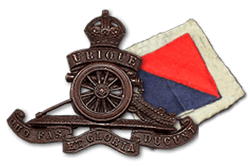71st (East Lancashire) Searchlight Regiment, Royal Artillery
The 71st (East Lancashire) Searchlight Regiment, Royal Artillery was an air defence unit of Britain's Territorial Army (TA), which was raised just before the outbreak of World War II and served as part of Anti-Aircraft Command during and after the war.
| 71st (East Lancashire) Searchlight Regiment, RA 606th (East Lancashire) Heavy Anti-Aircraft Regiment, RA | |
|---|---|
 Royal Artillery cap badge and AA patch of WWII | |
| Active | 1938–1955 |
| Country | |
| Branch | |
| Type | Searchlight Regiment |
| Role | Air Defence |
| Size | Regiment |
| Garrison/HQ | Failsworth Rusholme |
| Engagements | The Blitz |
Origin
As the international situation deteriorated in the late 1930s, the threat of air raids on the UK led to the rapid expansion in the number of anti-aircraft (AA) units manned by members of the part-time TA. Formed in November 1938, the unit was one of the first three TA searchlight regiments raised by the Royal Artillery (previous TA S/L units had all been part of the Royal Engineers and/or converted from infantry battalions).[1] It consisted of HQ and Nos 462–464 Companies (later Batteries) based in Failsworth, near Manchester. It was equipped with the new '90 cm Projector Anti-Aircraft', a smaller and lighter piece of equipment than previous searchlights, with a more powerful high current density arc lamp with automatic carbon feed.[1][2][3]

World War II
Anti-Aircraft Command mobilised in August 1939, ahead of the declaration of war on 3 September, and the regiment took its place in the 44th AA Brigade, part of the 4th AA Division tasked with defending the North West and North Midlands of England.[4][5][6] As a new regiment, it received instructors from the neighbouring 39th AA Battalion, Royal Engineers.[7]
In 1940, the regiment transferred to 53 Light AA Bde, covering the North Midlands.[8][9][10][11][12] The industrial cities of the North Midlands were targets for night bombing by the German Luftwaffe during the winter of 1940–41, the Nottingham Blitz on 8/9 May 1941 being a notable example. In 1941, the searchlight layout over the Midlands was reorganised, so that any hostile raid approaching the Gun Defended Areas (GDA) around the towns must cross more than one searchlight belt, and then within the GDAs the concentration of lights was increased.[13]
The regiment transferred to the command of 5 AA Bde on the South Coast of England in April 1943.[14] As the threat from the Luftwaffe waned, AA Command was forced to release men for other duties, and the number of active units was reduced in 1943, with the 71st S/L Rgt being reduced to a cadre in September. The following March, it was placed in 'suspended animation' and disappeared altogether.[3][4][8][15]
Postwar
When the TA was reconstituted in 1947, the 71st S/L Rgt was reformed at Rusholme, Manchester, as the 606th (Mixed) Heavy Anti-Aircraft Regiment, RA (East Lancashire), ('Mixed' denoting that members of the Women's Royal Army Corps were integrated into the unit). It formed part of 70 AA Bde (reformed from the former 44 AA Bde).[3][16][17][18][19]
However, AA Command was disbanded in April 1955 and there was a major reduction in the number of TA AA units. 606 HAA Rgt was amalgamated with other Manchester-based units to form 314 HAA Rgt, with 606 and 465 (Manchester Regiment) HAA Rgts providing P (Manchester) Bty.[3][18]
Memorial
On 1 January 1949, an oak clergy desk was unveiled in St John's Church, Failsworth, bearing the inscription: 'PRESENTED BY THE OFFICERS AND OTHER RANKS OF 71ST (E.L.) SEARCHLIGHT REGIMENT, ROYAL ARTILLERY T.A. TO COMMEMORATE THE FORMATION OF THE REGIMENT AND TO PERPETUATE ITS MEMORY 1938–1943'. The memorial is now lost.[20]
Notes
- Brigstock. Archived March 4, 2016, at the Wayback Machine
- Monthly Army List, January 1939.
- Litchfield, p. 135
- "4 AA Division 1939 at British Military History" (PDF). Archived from the original (PDF) on 2015-09-23. Retrieved 2015-11-29.
- AA Command 3 September 1939 at Patriot Files.
- Routledge, Table LVIII, p. 376; Table LX, p. 378.
- 39 S/L Rgt War Diary, 1939–41, The National Archives (TNA), Kew file WO 166/3057.
- "71 S/L Rgt at RA 39–45". Archived from the original on 2016-03-04. Retrieved 2015-11-29.
- 4 AA Division at RA 39–45. Archived 2015-09-24 at the Wayback Machine
- "4 AA Division 1940 at British Military History" (PDF). Archived from the original (PDF) on 2015-09-23. Retrieved 2015-11-29.
- Routledge, Table, LXV, p. 396.
- Farndale, Annex D, p. 260.
- Routledge, p. 399.
- Order of Battle of Non-Field Force Units in the United Kingdom, Part 27: AA Command, 13 March 1943, with amendments, TNA file WO 212/83.
- Routledge, pp. 399 & 409.
- Litchfield, Appendix 5, p. 333.
- Farndale, Annex M, p. 340.
- 592–638 Rgts RA at British Army 1945 on.
- 67–106 AA Bdes at British Army 1945 on. Archived 2016-03-04 at the Wayback Machine
- UK War Memorial Register Ref 44876.
References
- Gen Sir Martin Farndale, History of the Royal Regiment of Artillery: The Years of Defeat: Europe and North Africa, 1939–1941, Woolwich: Royal Artillery Institution, 1988/London: Brasseys, 1996, ISBN 1-85753-080-2.
- Norman E.H. Litchfield, The Territorial Artillery 1908–1988 (Their Lineage, Uniforms and Badges), Nottingham: Sherwood Press, 1992, ISBN 0-9508205-2-0.
- Brig N.W. Routledge, History of the Royal Regiment of Artillery: Anti-Aircraft Artillery 1914–55, London: Royal Artillery Institution/Brassey's, 1994, ISBN 1-85753-099-3